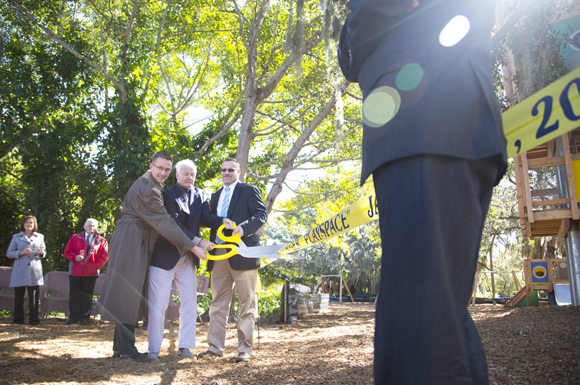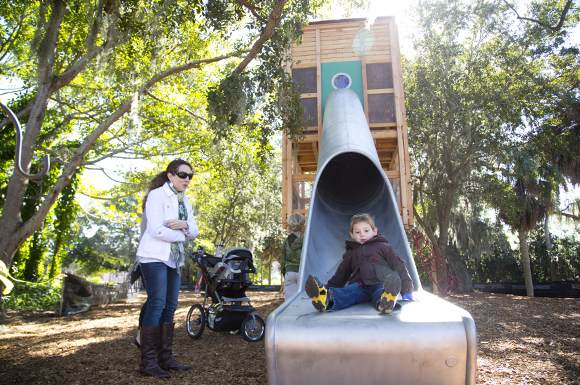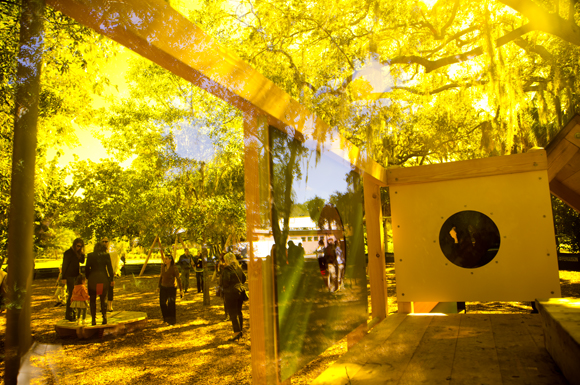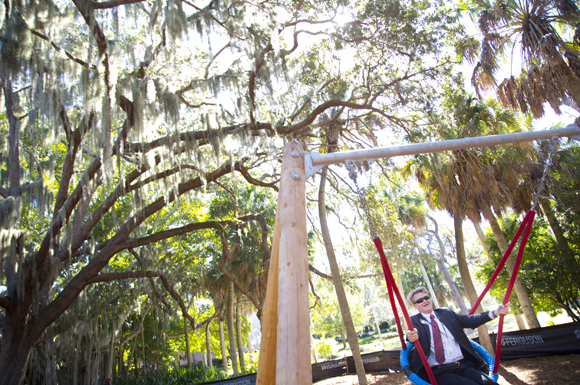Ringling Playspace Invites Children, Families To Step Outdoors
Children flock to a new outdoor playspace under the Banyan Trees at the stately Ringling Museum of Art in Sarasota. The space is possible following a private donation aimed at creating a place where kids (and their parents) can take a break to re-energize while touring exhibits.
A personal three-ring circus is what every parent hopes to avoid on a well-intentioned tour of an art museum with their children. Nevertheless, even professed child art-lovers are tired, cranky or numb by about hour two. In its world-class style, The Ringling Museum and Longboat Key Philanthropist David F. Bolger are bringing to life a playful solution in sharp relief to the formality of the museum and its grounds.
The new David F. Bolger Playspace is nestled adjacent to the rose garden on the Ringling Musuem’s 66-acre campus. Steven High, Executive Director of The John and Mable Ringling Museum of Art, says the newest installation is “celebrating the art of play” and fulfilling a “dream of the Museum’s to produce a space like this for families and children.”
With a big “snip!” of giant yellow scissors at a January ribbon-cutting, the Ringling Museum’s latest outdoor installation was officially inaugurated.
And just like that, the experts mobilized. A small flock of children, the first of thousands who will visit in a year, swooped in without a moment’s hesitation and immediately demonstrated its worthiness. Accompanying parents couldn’t stop smiling. (A few men in gray suits couldn’t resist bouncing and trying out the equipment, though they didn’t quite round out the image.)
“Sometimes the most creative play and learning comes from being in an area without walls,” says Bolger, a Longboat Key FL and Ridgewood NJ resident who, through his foundation, funded the $400,000 project. “It is important for children visiting the Museum to have an outdoor interactive area where they can use their imaginations in play. Where the imagination can roam free. We felt this was a great vehicle to achieve that goal.”
The Bolger Foundation has supported a variety of organizations with more than $100 million in philanthropic donations since 2000 always with the goal “to enhance quality of life.” This is Bolger’s second major contribution to the Ringling Museum following a $1 million grant in 2008 for refurbishing the property’s waterfront, creating The Bolger Promenade and Campiello.
Multigenerational And Multisensory
The Ringling project lead Dwight Currie, also the Museum’s curator of performance and associate director of programs, is pleased with how it turned out, but notes that “it wasn’t a sure bet.” During the 51-week process from concept to finish, there were some doubts, such as: “Will this be some jarring addition? Stylistically, will it mesh with the formal estate and gardens?” Ultimately, consensus grew around the idea that any playground noise is preferable to “children screaming at the top of their lungs in the Museum.”
When he saw the German-imported equipment in place, he says, “it was like somebody had a seed packet marked ‘toys’ and they threw the seeds out there and toys sprung up! It’s that organic and natural. A wonderful new amenity for families and kids.”
Jane Clark Chermayeff, guru of all things playground and the Ringling team’s design guide, says there are two overarching themes for innovative play spaces — they must promote free play as well as be a place where people of different generations and different abilities can have fun together. Chermayeff is the founder of New York-based Architecture Playground Equipment, and has extensive international experience working with affiliate Richter Spielgerate GmbH of Frasdorf, Germany, the manufacturer “at the forefront of innovative playground design” which created the equipment for the Ringling. She says she is satisfied the new playspace is “multigenerational, multisensory, accessible and collaborative, and it also supports the Museum’s mission to inspire, educate and entertain.”
Well-situated with proximity to restrooms and the cafe, the 37,500-square-foot playspace enjoys some natural magic, shaded by Banyan Trees and Spanish moss. Chermayeff points to the “cradle swings” as an example of multigenerational functionality. The swings are nest-like, maybe three feet in diameter. She notes that you can rock an infant there, gently, add in a grandmother, or alternatively, five little kids can climb on at the same time and swing hard.
The Simple Pleasure Of A Swing
Among the play stations, is a water diversion, sure to be popular in the warmer months, yet intentionally subdued enough to avoid, as Currie had feared, “seriously wet and muddy children.”
Perhaps the most noteworthy component of the park is its Mondrian-inspired structure, which looks something like an extraordinarily tall cubic tree house on metal stilts, complete with an approximately 15-foot high tube slide for easy exits. Spielgerate created it specifically for the Ringling playspace and is the only one in existence. Chermayeff predicts there will be lots of requests for it now.
Despite the innovations behind the scenes, the final product is quite straightforward. It is, after all a playground. Bolger, father of three and grandfather of five, had the vision from the start not to complicate things, that his intent was to give kids a place to play, jump and run-around. For his part, he says, he has “always enjoyed the simple pleasure of a swing.”
Kendra Langlie is a freelance writer and communications consultant based in Tampa. Comments? Contact 83 Degrees.


















